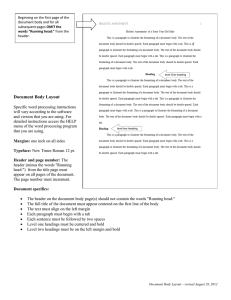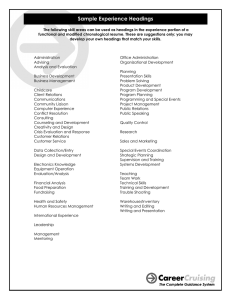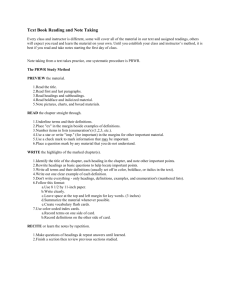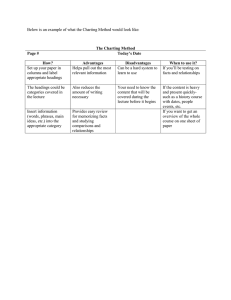Header 1 THE TITLE – ALL CAPS A Graduate Review
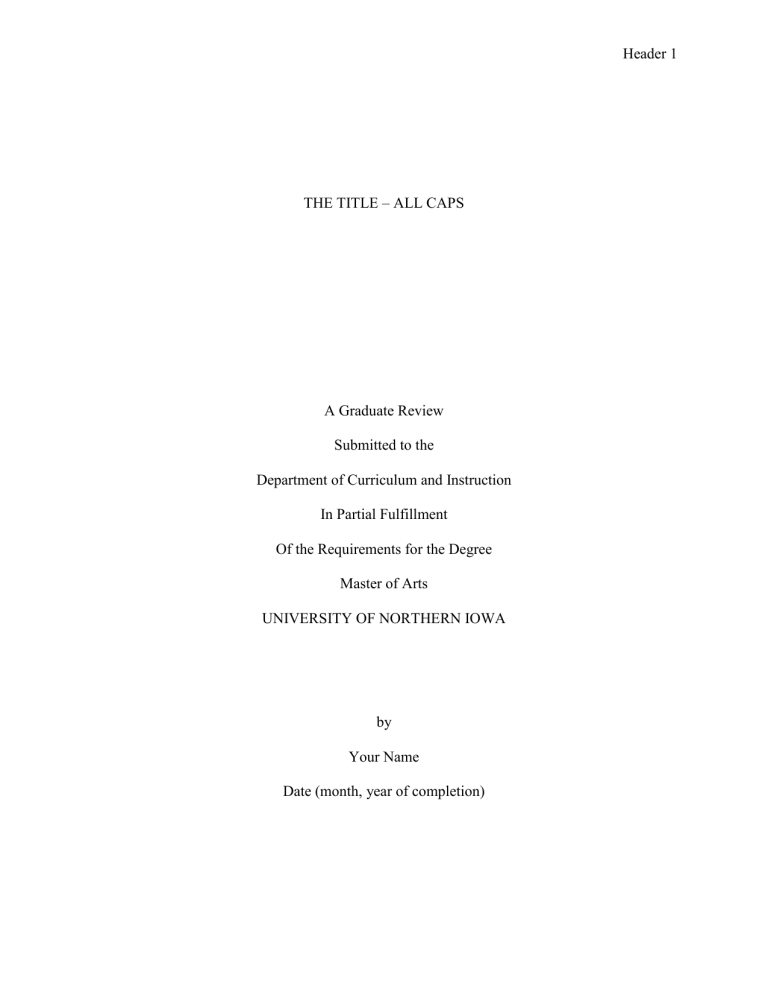
THE TITLE – ALL CAPS
A Graduate Review
Submitted to the
Department of Curriculum and Instruction
In Partial Fulfillment
Of the Requirements for the Degree
Master of Arts
UNIVERSITY OF NORTHERN IOWA by
Your Name
Date (month, year of completion)
Header 1
Header 2
This Review by: Your Name
Titled: Title of paper has been approved as meeting the research requirement for the
Degree of Master of Arts.
_______________
Date Approved
_______________
Date Approved
_______________
Date Approved
__________________________________________
Graduate Faculty Reader
__________________________________________
Graduate Faculty Reader
__________________________________________
Head, Department of Curriculum and Instruction
Header 3
Table of Contents
Introduction ...................................................................................................................................5
Methodology .................................................................................................................................6
Literature Review ..........................................................................................................................10
Enhancing Students’ Competencies through the Arts ..............................................................15
Involvement in the Arts and Students’ Performance in School ...............................................20
Extent of Students’ Learning in Schools with Arts-Infused Programs ....................................24
Conclusion and Recommendations ...............................................................................................27
Future Research ........................................................................................................................30
Teacher Practices (Self and Others ..........................................................................................43
References .....................................................................................................................................45
Appendix .......................................................................................................................................56
Header 4
Abstract
A new generation of students born after 1985 – the Net Generation or Digital Natives – is now entering public schools. Historical overview shows the picture of growing computer use by children in homes and in schools for the past 10 years. ICT (Information and Communication
Technologies) literacy skills and tools help students to acquire the skills needed to use the technologies within the classroom. National Educational Technology Standards (NETS) and
NETS performance indicators provide guidelines for teachers of what students should know and be able to do with technologies by the end of every grade level. This paper describes the ideas of various authors on how to integrate computer technologies into the elementary school curriculum and to overcome barriers of technology integration. The paper finishes with conclusions and recommendations for the integration of technology in schools.
Header 5
Introduction
Although there are obvious methodological and substantive differences among scientific disciplines, all require technical writing and most require beginning students to utilize specialized writing conventions. The interdisciplinary use of the fifth edition of the Publication
Manual of the American Psychological Association (2001) suggests the need for an expedient means of disseminating the essential features of this editorial style guide. Psychology students, like those of most other disciplines, invariably encounter difficulties in preparing papers that conform to this style.
This article provides a simplified guide for the development of technical writing skills reflecting the recommendations in the manual. The intent was to summarize essential features of this editorial style and include sufficient suggestions and examples to assist the undergraduate student with the organization and presentation of papers that conform to this latest edition of the
Publication Manual
In general, the Publication Manual recommends that one’s writing reflect brevity, orderliness, and flow of ideas, as well as decorum in phrasing. Flow of writing is enhanced by use of first-person pronouns ( I and we ) and is preferred over such phrases as the Researcher(s) when referring to oneself or the authors of the study. Again, although not explicit in the manual, the use of the second person ( you ) in the Results section is not considered appropriate; preferred are expressions where you is understood ( Note the findings in Table 1...
) or the passive form ( It should be noted from Table 1...
). Logical sequencing of ideas fosters orderliness of presentation.
Logical connection of ideas is reflected in the use of linking sentences and phrases at the beginning or ending of each paragraph. Avoid jargon, excessive detail, hyperbole, stereotypes in order to facilitate clarity, brevity, and good taste. Words and phrases are not emphasized through
Header 6 the use of bold print, underlining, single/double quote marks, or all uppercase characters. Instead, writers must construct sentences so that emphasis is understood. The exceptions to this rule are described and illustrated on pp. 119-120 Section 3.38) of the manual.
Consistency of verb tense facilitates the flow of thought and avoids distracting the reader.
Past and present perfect tense (e.g., have shown ) are suggested for the Introduction and
Procedure sections. Although not explicitly stated, the Participants portion of the Method section is presented in past tense, as normally would be the case for Apparatus , Materials , and
Design sections. If, for example, the materials consisted of a copyrighted test, use of the present tense to describe this instrument would be appropriate. Past tense alone and present tense, respectively, are recommended for the Results and Discussion sections. Finally, the Abstract should be presented in the same verb tense used in each respective section from which the content is drawn.
General Formatting
Margins should be uniform and a minimum of 1 inch on all sides. Content of typed and word-processed manuscripts should be left-justified and use a standard font such as Times New
Roman with 12 point font. Do not hyphenate words at the end of a sentence; end each line of text with a complete word. Double-space all lines including references. Number all pages starting with the title page. Page numbers are located in the upper-right corner of each page, 1 inch in from the right margin and between the top of the page and its 1 inch margin. Consistently and uniformly indent (either 5, 6, or 7 spaces from the left margin) new paragraphs using the word processing program’s default setting for the Tab key. APA-formatted manuscripts usually consist of distinct sections, some with subsections. The major sections normally use first-level headings while subsections are third level. Headings are described in greater detail in the next section.
Header 7
Headings
Most papers will require headings when switching topics. Headings should be as brief as possible. There are five levels of headings used in APA-style manuscripts. Many papers use only one or two levels of headings; most require no more than three levels of headings unless multiple studies are reported. If only one heading level is needed, it should be Level 1. Level 1 headings consist of centered words that are capitalized. Additional levels of headings are warranted if two or more subheadings are needed. Papers needing two levels of headings should use Levels 1 and
3; those requiring three levels should use 1, 3, and 4. Level 3 headings are italicized, and begin at the left margin. Text following level 1 and 3 headings begins on the next line. Level 4 headings are indented and italicized. Only the initial letter of the first word is capitalized and the heading ends with a period. Text following a level 4 heading begins on the same line as the heading. All headings should be brief (i.e., 2 or 3 words) and describe the section being introduced. Examples of levels 1, 3, and 4 are presented below:
Level One
Level Three
Level four . Refer to pp. 113-115 (sections 3.31-3.32) and pp. 289-290 (section 5.10) of the Publication Manual for more detailed directions on headings.
Paper Organization
All APA Style manuscripts have a title page containing the title of the paper, name(s) of the author(s), and their affiliation (centered left-to-right in the middle of the page, with each component on a separate line). The first line of the title page (left justified) is the optional Running head , which captures the essence of the title though in an abbreviated form.
The title of the paper should succinctly identify the nature of the investigation and
Header 8 variables/issues studied, and should not be more than 12 words. In the title, wording such as investigation of...
or study of...
is avoided because it is unnecessary. The name(s) of the author(s) is presented on the next line under the title. Author institutional affiliation(s) is on the line immediately under the name(s).
All papers must have a header. The header consists of the first two or three words of the title of the paper and a page number. The header is right justified with the page number appearing 5 spaces to the right of the last word. Manuscripts being submitted for possible publication should have a running head of up to 50 characters on the first line on the title page.
The phrase Running head is typed flush with the left margin at the top of the title page; the running head will replace the manuscript’s header if published in a journal, and is typed in all capital letters.
Header 9
References
American Psychological Association. (2001). Publication manual of the American Psychological
Association (5th ed.). Washington, DC: Author.
Cameron, J. Banko, K. M., & Pierce, W. D. (2001). Pervasive negative effects of rewards on intrinsic motivation: The myth continues [Electronic version].
The Behavior Analyst, 24 ,
1-44. Retrieved May 19, 2003, from http://www.abainternational.org/tbajournal/bhan-24-
01-0001.pdf
Catania, A. C. (l984). Learning (2nd ed.). Englewood Cliffs, NJ: Prentice Hall.
Deitz, S. M., & Hummel, J. H. (l978 ). Discipline in the schools: A guide to reducing misbehavior. Englewood Cliffs, NJ: Educational Technology Publications.
Fredrick, L. D., Deitz, S. M., Bryceland, J. A., & Hummel, J. H. (2000). Behavior analysis, education, and effective schooling . Reno, NV: Context Press.
Garavalia, L. S., Hummel, J. H., Wiley, L. P., & Huitt, W. G. (1999). Constructing the course syllabus: Faculty and student perceptions of important syllabus components. Journal on
Excellence in College Teaching, 10 (3), 5-21.
Grant, D. A. (l964). Classical and operant conditioning.
In A. W. Melton (Ed.),
Categories of human learning (pp. 1-31). New York: Academic Press.
Hall, J. T. (l976). Classical conditioning and instrumental learning: A contemporary approach.
Philadelphia: Lippincott.
Hummel, J. H., Huitt, W. G., Michael, R., & Walters, L. (1994, April). What you measure is what you get. A data-based presentation made at the annual meeting of the Southeastern
Psychological Association, New Orleans, LA. Retrieved August 29, 1997 from
Header 10 http://www.valdosta.edu/~jhummel/psy310/!tchrass.htm
Mechner, R. (1959). A notation system for the description of behavioral procedures. Journal of the Experimental Analysis of Behavior, 2 , 133-150.
Millenson, J. R. (1967). Principles of behavior analysis.
New York: MacMillan.
Schoenfeld, W. N., Cole, B. K., Blaustein, J., Lachter, G. D., Martin, J. M., Snapper, A. G.,
Kadden, R. M., & Inglis, G. B. (1982). State notation of behavioral procedures. Behavior
Research Methods and Instrumentation, 14, 329-342.
Woods, P. J. (l974). A taxonomy of instrumental conditioning. American Psychologist, 29 , 584-
597.
